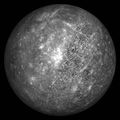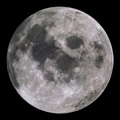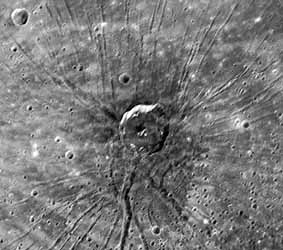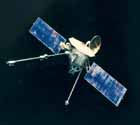|
News
Telescopes for Astronomy
|
Amazing image of Earth and the Moon taken by Messenger
24th August 2010
The image on the left is of Earth and the moon set against the vastness of space. The picture was snapped by NASA’s Messenger probe at a distance of 114 million miles (183 million km) and evokes memories of the Voyager 1 image of Earth taken from 3.7 billion miles away in 1990.
The image was taken during NASA’s search for Vulcanoids using the Messenger probe as it hurtles towards its final destination of the nearest planet to the sun, Mercury.
Vulcanoids, are asteroids that are thought to orbit between the sun and Mercury, although none have ever been discovered as yet and may not actually exist at all.
If found though they could contain material that could provide valuable clues as to how the rocky inner planets formed.
The name Vulcanoids comes from the hypothetical planet Vulcan which was at one time thought to orbit between the sun and Mercury.
The Messenger spacecraft has already had quite a journey since its launch in 2004. The probe has used both Venus and Earth as gravity assists and has already made three flybys of Mercury gathering valuable new information about the inner most planet.
Messenger will be placed in orbit around Mercury in March 2011 when it will begin a year long study of the planet.
More Stories
Surface
Mercury's surface appears to be much like that of the moon. It is covered by a thin layer of minerals called silicates in the form of tiny particles.
Like the moon it has flat plains, steep cliffs and many deep craters.
Atmosphere
Mercury has very little atmosphere, only tiny amounts of helium, hydrogen, oxygen and sodium. Because of the lack of atmosphere Mercury's sky is black with stars being visible during the day.
Temperature
Mercury doesn't have enough atmosphere to protect it from the sun's rays. The temperature on the planet may reach 450C (840F) during the day but at night the temperature may drop as low as -170C (-275F).
Mercury doesn't have enough atmosphere.
| Moons & Origin of Name |
| Life on Mercury |
Mercury has no moons.
The Romans named the planet after the messenger to the gods.
The Romans named the planet after the messenger to the gods.
Scientists doubt that the planet has any form of life.
| Is Mercury Just Like the Moon? |


| Planet Mercury - Images and Videos |
Mercury close up
Messenger images of Mercury
"Spider" Impact crater


|
Planet Mercury - Vital Statistics
Comparison with Earth
|
Diameter: 3,032 miles (4,880 km)
Average Distance from Sun: 36 million miles (58 million km)
Orbital Period: 88 days
Rotation Period: 59 days
Moons: 0
Maximium Surface Temperatures: 450C (840F)
Minumum Surface Temperatures: -170C (-275F)
Gravity: 3.7 m/s2 (38% Earth's Gravity)
Density: 5.427 g/cm3 (98.4% Earth's Density)
Mass: 3.3022 x 1023 kg (5.5% Earth's Mass)
Volume: 6.08272 x 1010 km3 (5.6% Earth's Volume)
Atmosphere: 42% Molecular oxygen, 29.0% sodium, 22.0% hydrogen, 6.0% helium, 0.5% potassium, Trace amounts of argon, nitrogen, carbon dioxide, water vapor, xenon, krypton and neon.
Average Distance from Sun: 36 million miles (58 million km)
Orbital Period: 88 days
Rotation Period: 59 days
Moons: 0
Maximium Surface Temperatures: 450C (840F)
Minumum Surface Temperatures: -170C (-275F)
Gravity: 3.7 m/s2 (38% Earth's Gravity)
Density: 5.427 g/cm3 (98.4% Earth's Density)
Mass: 3.3022 x 1023 kg (5.5% Earth's Mass)
Volume: 6.08272 x 1010 km3 (5.6% Earth's Volume)
Atmosphere: 42% Molecular oxygen, 29.0% sodium, 22.0% hydrogen, 6.0% helium, 0.5% potassium, Trace amounts of argon, nitrogen, carbon dioxide, water vapor, xenon, krypton and neon.
Diameter: 7,926 miles (12,756 km)
Average Distance from Sun: 93 million miles (150 million km)
Orbital Period: 365.24 days
Rotation Period: 23.934 hours
Moons: 1
Maximium Surface Temperatures: 58C (136F)
Minumum Surface Temperatures: -88C (-126F)
Gravity: 9.766 m/s2
Density: 5.515 g/cm3
Mass: 5.9737 x 1024 kg
Volume: 1.0832 x 1012 km3
Atmosphere: 78.08% nitrogen, 20.95% oxygen, 0.93% argon, 0.038% carbon dioxide, water vapour makes up around 0.4% of Earth's atmosphere depending on climatic conditions.
Average Distance from Sun: 93 million miles (150 million km)
Orbital Period: 365.24 days
Rotation Period: 23.934 hours
Moons: 1
Maximium Surface Temperatures: 58C (136F)
Minumum Surface Temperatures: -88C (-126F)
Gravity: 9.766 m/s2
Density: 5.515 g/cm3
Mass: 5.9737 x 1024 kg
Volume: 1.0832 x 1012 km3
Atmosphere: 78.08% nitrogen, 20.95% oxygen, 0.93% argon, 0.038% carbon dioxide, water vapour makes up around 0.4% of Earth's atmosphere depending on climatic conditions.
| Future and Past Missions to Mercury |


